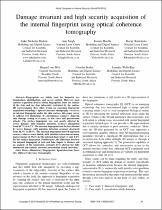 ResearchSpace
ResearchSpace
Damage invariant and high security acquisition of the internal fingerprint using optical coherence tomography
JavaScript is disabled for your browser. Some features of this site may not work without it.
- ResearchSpace
- →
- Research Publications/Outputs
- →
- Conference Publications
- →
- View Item
| dc.contributor.author |
Darlow, Luke N

|
|
| dc.contributor.author |
Singh, Ann

|
|
| dc.contributor.author |
Moolla, Yaseen

|
|
| dc.contributor.author |
Ramokolo, Lesiba R

|
|
| dc.contributor.author |
Van Wyk, R

|
|
| dc.contributor.author |
Botha, Natasha

|
|
| dc.contributor.author |
Webb-Ray, L

|
|
| dc.date.accessioned | 2017-07-28T08:59:34Z | |
| dc.date.available | 2017-07-28T08:59:34Z | |
| dc.date.issued | 2016-11 | |
| dc.identifier.citation | Darlow, L.N., Singh, A., Moolla, Y. et al. 2016. Damage invariant and high security acquisition of the internal fingerprint using optical coherence tomography. World Congress on Internet Security (WorldCIS-2016), 14-16 November 2016, London, United Kingdom, p. 34-40 | en_US |
| dc.identifier.isbn | 978-1-908320-66-7 | |
| dc.identifier.uri | http://hdl.handle.net/10204/9312 | |
| dc.description | World Congress on Internet Security (WorldCIS-2016), 14-16 November 2016, London, United Kingdom | en_US |
| dc.description.abstract | Fingerprints are widely used for biometric authentication, identification, and access control. However, most current acquisition devices obtain fingerprints from the surface of the skin and are thus inherently restricted by the surface 2D representation they offer. Using an emerging fingerprint acquisition technology – optical coherence tomography – to access an internal fingerprint under the skin surface, this paper serves to address two limitations of conventional scanners: fingertip skin damage (owing to eczema, in this case) and presentation attacks. The surface fingerprint was very poorly affected by severe damage, with minutiae detection accuracy diminished from 88.7% to 4.7%. The internal fingerprint was far less affected by severe damage, with minutiae detection accuracy decreased from 81.3% to 40.5%. The internal fingerprint showed improved recovery when eczema abated, with minutiae extraction accuracy improvements of 35.6% for the internal fingerprint yet only 0.6% for the surface fingerprint. Furthermore, the difference between the internal fingerprint of real and fake fingers is distinct and an analysis of the orientation certainty level allowed for fully automated and entirely accurate presentation attack detection. | en_US |
| dc.language.iso | en | en_US |
| dc.publisher | Infonomics Society | en_US |
| dc.relation.ispartofseries | Worklist;18504 | |
| dc.subject | Biometrics | en_US |
| dc.subject | Fingerprints | en_US |
| dc.subject | Spoof-detection | en_US |
| dc.subject | Security | en_US |
| dc.subject | Optical coherence tomography | en_US |
| dc.title | Damage invariant and high security acquisition of the internal fingerprint using optical coherence tomography | en_US |
| dc.type | Conference Presentation | en_US |
| dc.identifier.apacitation | Darlow, L. N., Singh, A., Moolla, Y., Ramokolo, R., Van Wyk, R., Botha, N., & Webb-Ray, L. (2016). Damage invariant and high security acquisition of the internal fingerprint using optical coherence tomography. Infonomics Society. http://hdl.handle.net/10204/9312 | en_ZA |
| dc.identifier.chicagocitation | Darlow, Luke N, Ann Singh, Yaseen Moolla, Rocky Ramokolo, R Van Wyk, Natasha Botha, and L Webb-Ray. "Damage invariant and high security acquisition of the internal fingerprint using optical coherence tomography." (2016): http://hdl.handle.net/10204/9312 | en_ZA |
| dc.identifier.vancouvercitation | Darlow LN, Singh A, Moolla Y, Ramokolo R, Van Wyk R, Botha N, et al, Damage invariant and high security acquisition of the internal fingerprint using optical coherence tomography; Infonomics Society; 2016. http://hdl.handle.net/10204/9312 . | en_ZA |
| dc.identifier.ris | TY - Conference Presentation AU - Darlow, Luke N AU - Singh, Ann AU - Moolla, Yaseen AU - Ramokolo, Rocky AU - Van Wyk, R AU - Botha, Natasha AU - Webb-Ray, L AB - Fingerprints are widely used for biometric authentication, identification, and access control. However, most current acquisition devices obtain fingerprints from the surface of the skin and are thus inherently restricted by the surface 2D representation they offer. Using an emerging fingerprint acquisition technology – optical coherence tomography – to access an internal fingerprint under the skin surface, this paper serves to address two limitations of conventional scanners: fingertip skin damage (owing to eczema, in this case) and presentation attacks. The surface fingerprint was very poorly affected by severe damage, with minutiae detection accuracy diminished from 88.7% to 4.7%. The internal fingerprint was far less affected by severe damage, with minutiae detection accuracy decreased from 81.3% to 40.5%. The internal fingerprint showed improved recovery when eczema abated, with minutiae extraction accuracy improvements of 35.6% for the internal fingerprint yet only 0.6% for the surface fingerprint. Furthermore, the difference between the internal fingerprint of real and fake fingers is distinct and an analysis of the orientation certainty level allowed for fully automated and entirely accurate presentation attack detection. DA - 2016-11 DB - ResearchSpace DP - CSIR KW - Biometrics KW - Fingerprints KW - Spoof-detection KW - Security KW - Optical coherence tomography LK - https://researchspace.csir.co.za PY - 2016 SM - 978-1-908320-66-7 T1 - Damage invariant and high security acquisition of the internal fingerprint using optical coherence tomography TI - Damage invariant and high security acquisition of the internal fingerprint using optical coherence tomography UR - http://hdl.handle.net/10204/9312 ER - | en_ZA |





